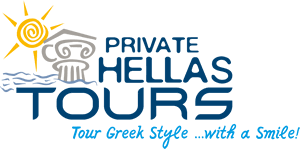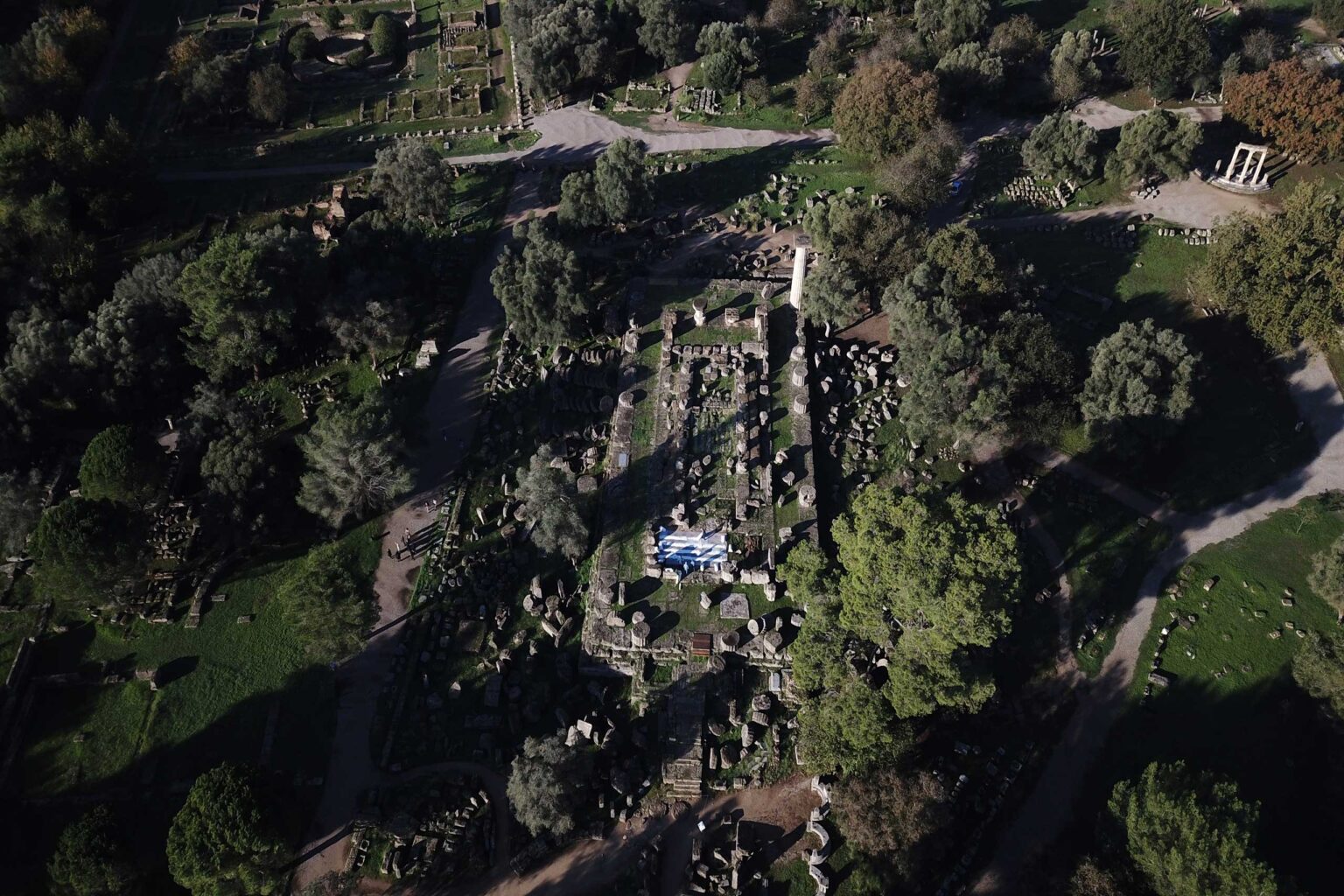We will visit:
- The Corinth Canal
- Ruins of the Ancient Corinth city
- Mycenae
- Nafplion
- Theater of Epidaurus
- Ancient Olympia & Museum
Argolis and Olympia two days tour begins driving west along the National Highway, until we reach the Corinth Canal or else Isthmus completed in 1893 – 6 km length, 25m width, 8m depth- which connects the Aegean with the Ionian Sea. Our 15’ stop there gives us the opportunity to take some marvelous pictures and then continue our route until we reach the Ruins of the city of Ancient Corinth. You can see the long rocky wall of Acrocorinth leading to Lechaion (artificial harbor of the Corinthian Gulf) where the road leading to Ancient Agora starts. The Temple of Apollo (6th c. B.C.-restored 1st c. AD) is the only Greek monument standing, as all others are mainly Roman.
Another interesting spot to see is the museum of Acrocorinth which hosts many objects and findings like the head of Goddess Tyche (Luck), the Bema where Saint Paul preached, and the fountain of Glauke.
Continuing our tour we drive to reach Argolid Epidaurus, known for its sanctuary, as it was the birthplace of Apollo’s son Asclepius the healer. The Asclepeion at Epidaurus was the most celebrated healing center of the Classical world. The prosperity brought by the Asclepeion enabled Epidaurus to construct civic monuments, including the huge Ancient Theater of Epidaurus worldwide known for its perfect acoustics to all 15.000 spectators, its symmetry and beauty, which is used again today for dramatic performances. The advanced design of the rows of limestone seats filter out low-frequency sounds, such as the murmur of the crowd, and amplify high-frequency sounds from the stage.
Driving through the citrus fruit Argolis plain we reach Nafplion a seaport city expanding up the hillsides near the north end of the Argolic Gulf. Count Ioannis Kapodistrias, first head of state of newly liberated Greece, made it the official capital of the First Hellenic Republic in 1829 until 1834. We will have the opportunity to see Acronafplia the oldest part of the city. Until the thirteenth century, it was a town on its own. Other fortifications of the city to visit are the Palamidi Castle with 999 steps to climb and Bourtzi island, which is located in the middle of the harbor. There we take lunch at a sea view restaurant.
Leaving Nafplion we visit Mycenae ‘Rich in Gold’, the kingdom of mythical Agamemnon, and the most important and richest palatial centre of the Late Bronze Age in Greece. Its name was given to one of the greatest civilizations of Greek prehistory, the Mycenaean civilization. Great Cyclopean walls surround the almost triangular acropolis, accessed through the famous Lion Gate, symbol of the Mycenaean rulers’ power, like Pelops, father of Agamemnon and Menelaos. We can see Grave Circle A, whose six large shaft graves contained numerous gold objects and other works of art. Outside the fortification walls, west of the Lion Gate, is Grave Circle B, which encloses fourteen shaft-graves. The “Treasure of Atreus (Agamemnon)” the most impressive of the preserved Mycenaean tholos tombs, situated at Mycenae, on Panagitsa hill, was constructed in ca. 1250 B.C. and was in use for a long period.
Departing from Mycenae in the afternoon we follow the route through the mountains to reach Olympia where we have our overnight stay. After our breakfast we wonder at Ancient Olympia site, the place where the worldwide known Olympic Games took place in antiquity to honor Zeus.
The Altis is the sacred enclosure of the main part of the sanctuary includes the sanctuary of Zeus, the Temple of Hera where the Olympic Flame lights up every 4 years and the many buildings erected around them used as athletic premises for the preparation, celebration, administration needs of the Olympic Games, as well as treasuries, baths, hostels and monuments for the crowds that over flew Olympia during the games. Such examples are: Bouleuterion or Council House, the Prytaneion, the stadium of Olympia, the Ancient Gymnasium, the Palaestra, the Hippodrome, the Workshop of Pheidias where the great sculptor crafted the gigantic chryselephantine statue of Zeus, listed as one of the Seven Wonders of the ancient world, the Pedestal of the Nike of Paionios, the remarkable Classical statue e.t.c.
We continue our visit with the Archaeological Museum of Olympia– reorganized in 2004,one of the most important museums in Greece, exhibits in its 12 exhibition rooms objects excavated in the Altis. Such findings are: the statue of Hermes of Praxiteles, the statue of Nike Paionios, figures of east and west Pediment and Metopes of Zeus Temple, the clay Complex of Zeus with Gnymedes and Miltiades’ Helmet.
Departing the museum and after having lunch at a nice traditional restaurant we take our route back to Athens along the national highway…
Argolis & Olympia Tour Details
Duration : 2 days
Booking Request
Tickets and Opening Hours
Tickets : Full: €12, Reduced: €6
- Opening Hours
- Winter : Monday – Sunday : 08.00 – 15.00 (Last admission : 20′ before closing)
- Summer : 8:00-20:00 (Last admission : 20′ before closing)
Tickets : Full : 12€, Reduced : 6€
Valid for : Archaeological Museum of Olympia & Olympia
Tickets : Full: €12, Reduced: €6
Tickets : Full: 8€, Reduced: 4€
Palamidi is open every day
Wintertime: 8:30-15:30
From November 1st to March 31st: 08:30-16:00
Summertime:
April to August: 08:00-20:00
September 1st to September 15th: 08:00-19:30
September 16th to September 30th: 08:00-19:00
October 1st -to October 5th: 08:00-18:30
October 16th to October 31st: 08:00-18:00
Good Friday: 12.00-17.00 Holy Saturday: 08.30-16.00
- March 6 (in memory of Melina Mercouri)
- April 18 (International Monuments Day)
- May 18 (International Museums Day)
- June 5 (International Enviroment Day)
- September 27 (International Tourism Day)
- October 28 (Greek National Holiday)
- The last weekend of September (European Heritage Days)
- Sundays from November 1st till March 31st
- The first Sunday of every month except July, August & September
- Admission is free for the students of EU and children under 18 years.
- People with special needs free; there is no ramp and no wheelchair is provided
Your professional driver has limited knowledge of Greek history, mythology as well as contemporary life and traditions. He is not allowed by law to accompany you into the sites and museums; therefore he will be waiting for you at the agreed area.
Private Hellas Tours cooperates with professional, licensed private tour guides, that you can hire and will ride the same vehicle with you, accompany you to the sites and museums and give you detailed information on the history of the landmarks and historical sites.

